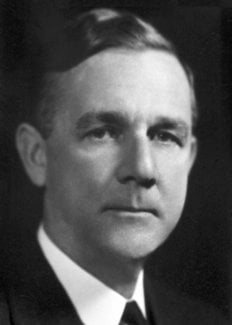George H. Whipple
Biographical

George Hoyt Whipple was born on August 28, 1878, in Ashland, New Hampshire, U.S.A., the son of Dr. Ashley Cooper Whipple and his wife Frances Hoyt. His paternal grandfather and his father, both physicians, were born and bred in New Hampshire.
Whipple was educated at Andover Academy and then went to Yale University, where he took his A.B.degree in 1900. Subsequently he went to Johns Hopkins University, where he took his M.D. degree in 1905.
In 1905 he was appointed Assistant in Pathology at the Johns Hopkins Medical School and, although he spent a year as pathologist to the Ancon Hospital, Panama, he remained at Johns Hopkins University until 1914, being successively Assistant, Instructor, Associate and Associate Professor in Pathology.
In 1914 he was appointed Professor of Research Medicine at the University of California Medical School, and Director of the Hooper Foundation for Medical Research at that University, being Dean of the Medical School during the years 1920 and 1921. In 1921 he was appointed Professor of Pathology and Dean of the School of Medicine and Dentistry at the University of Rochester.
Whipple’s main researches were concerned with anaemia and the physiology and pathology of the liver. For a year he worked under General William Gorgas and Dr. S. T. Darling on anaemia caused by parasitic infections and especially on the lesions found in the intestinal tract in people suffering from these infections. He also studied the histology of the tissues in patients suffering from blackwater fever.
When he went to Johns Hopkins University as an assistant in the Department of Pathology, Whipple worked under William H. Welch on pigments related to liver necrosis caused by chloroform anaesthesia, his aim being to gather information about repair and regeneration of the liver cells. This problem was studied in the dog, and Whipple found that the liver cells had an almost limitless power of regeneration. He then became interested in jaundice, which is always associated with chloroform poisoning and injury to the liver. He studied the route by which the bile pigments pass into the blood and thus produce jaundice of various parts of the body and he found that the lympathic system was of little importance in transporting them. He then studied, by means of bile fistulas and other means, the bile pigments and their production outside the liver, and in this work he collaborated with C. W. Hooper.
After his appointment at the Hooper Foundation, Whipple continued his work with bile fistulas, and soon found that a better understanding of the production of haemoglobin was needed if the metabolism of bile pigments was to be understood. In collaboration with C. W. Hooper and Mrs. Robscheit-Robbins, he did experiments on short-term anaemia in dogs due to loss of blood, and further work was done on this subject and on diets consisting of liver in relation to the regeneration of blood. In Rochester, however, he decided to use anaemias due to blood loss which were uniformly sustained and were long maintained, and to study the effects on these of various factors in diets added to the rations. This work showed that the most effective addition to the diets was raw liver itself. For this work on the therapeutic value of liver in the treatment of pernicious anaemia he was awarded, together with George R. Minot and William P. Murphy, the Nobel Prize for Physiology or Medicine in 1934.
Whipple has, in addition to the researches just described, worked on tuberculosis, pancreatitis, chloroform poisoning in animals, the metabolism of pigments and iron, the constituents of the bile, and the regeneration of plasma protein, and he has studied protein metabolism by means of lysine labelled with 14C, and also vitamin B12 labelled with 60Co, and its distribution and functions in the body. He has also made studies of the stroma of red blood cells.
Among the many honours and distinctions he received are honorary doctorates of several American Universities as well as of the Universities of Athens and Glasgow; the Popular Science Monthly Gold Medal and Annual Award in 1930 (with Dr. Minot), and the William Wood Gerhard Gold Medal of the Pathological Society of Philadelphia, in 1934.
He is a Trustee of the Rockefeller Foundation. He is also a Corresponding Member of the Association of Physicians in Vienna and of the Royal Society of Physicians in Budapest, and of the European Society of Haematology, and a Foreign Corresponding Member of the British Medical Association. He is an Honorary Member of the Pathological Society of Great Britain and Ireland, and of the American Philosophical Society and the Society of Experimental Biology and Medicine. He was, from 1936-1953, a member of the Board of Scientific Directors of the Rockefeller Institute, a member of the Board of Trustees of this Foundation from 1939-1953, Vice-Chairman of its Board of Trustees from 1953-1960, and in 1960 he was appointed Trustee Emeritus.
In 1914 Whipple married Katherine Ball Waring of Charleston, South Carolina. He has one son George Hoyt (b. 1917) and one daughter Barbara (b. 1921), and seven grandchildren.
This autobiography/biography was written at the time of the award and first published in the book series Les Prix Nobel. It was later edited and republished in Nobel Lectures. To cite this document, always state the source as shown above.
George H. Whipple died on February 1, 1976.
Nobel Prizes and laureates
Six prizes were awarded for achievements that have conferred the greatest benefit to humankind. The 14 laureates' work and discoveries range from quantum tunnelling to promoting democratic rights.
See them all presented here.
